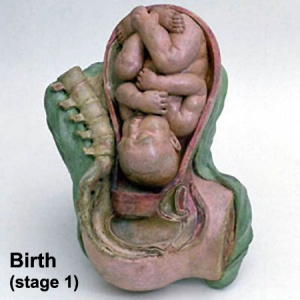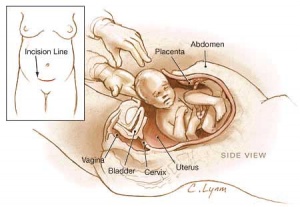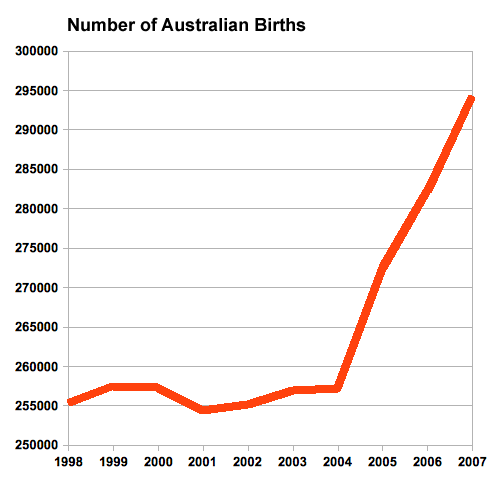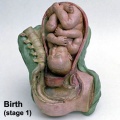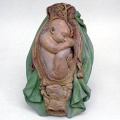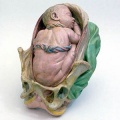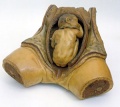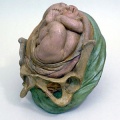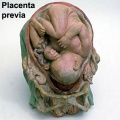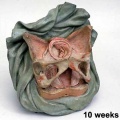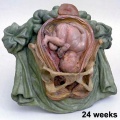Birth
Introduction
Birth or parturition is a critical stage in development, representing in mammals a transition from direct maternal support of fetal development, physical expulsion and establishment of the newborns own respiratory, circulatory and digestive systems. These notes only cover the biological processes surrounding birth including fetal signaling changes and maternal signaling changes. Note that there is a growing worldwide trend in developed countries toward caesarean section delivery. There are a great number of comprehensive, scientific and general, books and articles that cover birth, childbirth or parturition. The time surrounding birth is known as the perinatal period.
- --Mark Hill 09:00, 6 August 2009 (EST) Page under development - notice removed when completed.
USA Live Births and Fertility Rates
2007 Data [1] Number of births: 4,317,119 Birth rate: 14.3 per 1,000 population Fertility rate: 69.5 births per 1000 women aged 15-44 years Percent born low birthweight: 8.2% Percent unmarried: 39.7%
Australian Data
Historic Birth Models
About The Models - a series of models commissioned by Giuseppe Galletti (? - 1819) currently held in the Institute and Museum of the History of Science (Italy) Istituto e Museo di Storia della Scienza (IMSS). Giuseppe Galletti and others used terracotta and wax models that he had commissioned in Florence between 1770 and 1775 to train surgeons and midwives.
About The Models - One of a series of models commissioned by Giuseppe Galletti (? - 1819) currently held in the Institute and Museum of the History of Science (Italy) Istituto e Museo di Storia della Scienza (IMSS). Giuseppe Galletti and others used terracotta and wax models that he had commissioned in Florence between 1770 and 1775 to train surgeons and midwives. Wax models are life-sized and the terracotta versions are reduced to a 1:3 scale.
- Galletti models: birth | Week 10 Fetus Model | Week 16 Fetus Model | Week 24 Fetus Model | Stage 1 Terracotta Model 1 | Stage 2 Terracotta Model 2 | Stage 1 Wax Model | Breech Birth 1 | Breech Birth 2 | Breech Birth 3 | Breech Birth Wax Model | Placenta Previa | Category:Galletti1770 | 17th and 18th Century Anatomies | Embryology History | Embryology Models
Image Source: Institute and Museum of the History of Science http://brunelleschi.imss.fi.it/museum/esim.asp?c=500156 Thanks to Sabina Bernacchini from Institute and Museum of the History of Science (Italy) IMSS for allowing reproduction of selected images from the Surgery and Obstetrics exhibition on this embryology education site.
Cite this page: Hill, M.A. (2024, May 8) Embryology Birth. Retrieved from https://embryology.med.unsw.edu.au/embryology/index.php/Birth
- © Dr Mark Hill 2024, UNSW Embryology ISBN: 978 0 7334 2609 4 - UNSW CRICOS Provider Code No. 00098G
Additional Images
See Category:Birth
Birth Weights
| Birth weight (grams) | less 500 | 500 – 999 | 1,000 – 1,499 | 1,500 – 1,999 | 2,000 – 2,499 | 2,500 – 2,999 | 3,000 – 3,499 | 3,500 – 3,999 | 4,000 – 4,499 | 4,500 – 4,999 | 5,000 or more |
| Classification | Extremely Low Birth Weight | Very Low Birth Weight | Low Birth Weight | Normal Birth Weight | High Birth Weight | ||||||
Extremely Low Birth Weight
Less than 500 grams (1 lb 1 oz or less)
500 – 999 grams (1 lb 2 oz – 2 lb 3 oz)
Very Low Birth Weight
1,000 – 1,499 grams (2 lb 4 oz – 3 lb 4 oz)
Low Birth Weight
1,500–1,999 grams (3 lb 5 oz – 4 lb 6 oz)
2,000–2,499 grams (4 lb 7 oz – 5 lb 8 oz)
Normal Birth Weight
2,500–2,999 grams (5 lb 9 oz – 6 lb 9 oz)
3,000–3,499 grams (6 lb 10 oz – 7 lb 11 oz)
3,500–3,999 grams (7 lb 12 oz – 8 lb 13 oz)
High Birth Weight (macrosomia)
4,000–4,499 grams (8 lb 14 oz – 9 lb 14 oz)
4,500–4,999 grams (9 lb 15 oz – 11 lb 0 oz)
5,000 grams or more (11 lb 1 oz or more)
The primary causes of VLBW are premature birth (born <37 weeks gestation, and often <30 weeks) and intrauterine growth restriction (IUGR), usually due to problems with placenta, maternal health, or to birth defects. Many VLBW babies with IUGR are preterm and thus are both physically small and physiologically immature.
References
- ↑ USA National Vital Statistics System - Birth Data
Search Pubmed: Birth
| System Links: Introduction | Cardiovascular | Coelomic Cavity | Endocrine | Gastrointestinal Tract | Genital | Head | Immune | Integumentary | Musculoskeletal | Neural | Neural Crest | Placenta | Renal | Respiratory | Sensory | Birth |
